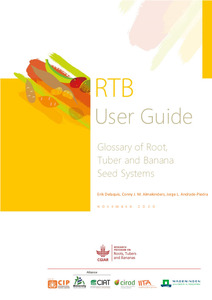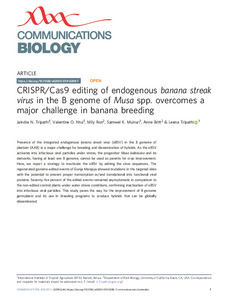Tagging products with barcodes for easy price retrieval in supermarkets is now a regular practice that people often take for granted. But beyond supermarkets, barcodes can be employed across a whole spectrum of settings, including by scientists in their research.
The Accelerated Breeding Better Bananas project has developed, adapted, finetuned, and deployed a fully operational Banana breeding Tracking Tool (BTracT), which uses barcodes. BTracT has also benefitted from the support and collaboration through the CGIAR Research Program on Roots, Tubers and Banana (RTB). Researchers now use BTracT to routinely track each step of the breeding process of the breeding pipeline, from where the male parent’s pollen comes from to how the cooked product tastes.

Barcoded trees in a banana breeding field. Photo credit: IITA
Each plant in each location receives a specific barcode identity. Apart from parental pedigree and taste details, BTracT records agronomic performance, pest resistance, plant stature, color, and feel of cooked bananas. These details are stored on the global banana breeding database MusaBase for all to access. The banana breeding process is extensive, and the performance of plants studied over several years can help identify the best performing and most suitable bananas with the most desired traits.
“Having real-time upload of data allows supervisors to keep track of operations while away from the Station. If a problem occurs, I am aware of it almost at the same time as the people on the ground. It also simplifies reporting as data needed for reports can quickly be accessed, also from anywhere in the world,” IITA Banana Breeder Allan Brown explained.
While banana is an important food and cash crop for millions of subsistence farmers in developing countries, its yield is still low. In Uganda, for example, the average yield of banana is 10 t/ha/year, yet has a potential yield of 60 t/ha/year and above. The low yield is attributed to both abiotic and biotic constraints.
Banana breeding is the most feasible intervention to solve these constraints and involves several extensive steps. Accurately tracking a breeding program’s progress and performance at all the different levels is an involving and time-consuming activity but BTracT simplifies this process. By helping identify the best hybrids without laboriously wading through reams of data, BTracT is transforming banana breeding and revolutionizing the whole process.
BTracT allows data capture on handheld devices, synchronizes data from various locations, and enables querying and analytics on a central dashboard. “This definitely makes data collection much more efficient and accurate, to the joy of the research assistants. We now receive data much more timely, usually the day after collection,” said Violet Akech, a research associate on Banana improvement at Sendusu station.
BTracT is now fully operational with the IITA banana breeding programs in Sendusu, Uganda and Arusha, Tanzania, across the entire workflow. It is also fully integrated into MusaBase, enabling seamless real-time data handling and data flow.
“We are now able to mine the data collected to improve the efficiency of the breeding program and also have important insights into biological processes that have been bottlenecks in Banana breeding. We see this as an important step towards being a data-driven breeding program,” added Trushar Shah, one of the system’s developers.
Several private companies involved in banana tissue culture and seedling distribution systems are already enthusiastic about adapting BTracT to their systems. The banana breeding team is working closely with all interested partners to extend the use of BTracT to these systems.
Originally published on IITA.



